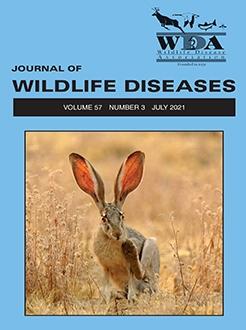Marine birds are frequently found dead on beaches, either from natural or from anthropogenic causes. Complete necropsies of those carcasses can provide valuable information, particularly for pelagic species, such as Northern Fulmars (Fulmarus glacialis) and shearwaters, which come to land only to breed and for which information on diseases that may affect them is, therefore, sparse. Between 2000 and 2012, 315 carcasses of four species of Procellariiformes (173 Northern Fulmars, 89 Great Shearwaters [Ardenna gravis], 50 Sooty Shearwaters [Ardenna grisea], and three Cory's Shearwaters [Calonectris diomedea]) were collected on Sable Island, Nova Scotia, Canada, an isolated island near the edge of the continental shelf. A complete necropsy, including examination for the presence of ingested plastic, was performed on all carcasses. Most (70%) of these birds were immature. The cause of death was undetermined in 22% (n=70) of the birds: 36% (62/173) of the Northern Fulmars, 4% (4/89) of the Great Shearwaters, 6% (3/50) of the Sooty Shearwaters, and 33% (1/3) of the Cory's Shearwaters. Emaciation was considered the primary cause of death in 91% of the remaining 245 birds: 87% (97/111) of the Northern Fulmars, 92% (78/85) of the Great Shearwaters, 100% (47/47) of the Sooty Shearwaters, and 100% (2/2) of the Cory's Shearwaters. Notable primary causes of death other than emaciation included mycobacteriosis and neoplasia in Northern Fulmars and transmural parasitic proventriculitis in Great Shearwaters. For Northern Fulmars, nutritional condition (as determined semiquantitatively) was compared with other parameters. Birds in good nutritional condition had heavier body mass and flight muscle mass than those in poor nutritional condition (P<0.01). More adults were in poor nutritional condition than expected by chance (91%; χ2=8.23, P<0.01), whereas only 57% of immature birds were in poor condition. There was no relationship between nutritional condition and sex or mass of ingested plastic. Our study provides information on some previously unsuspected health threats in Procellariiformes.
How to translate text using browser tools
5 July 2021
PATHOLOGY OF NORTHERN FULMARS (FULMARUS GLACIALIS) AND SHEARWATERS BEACHED ON SABLE ISLAND, NOVA SCOTIA, CANADA
Pierre-Yves Daoust,
Sarah Wong,
Erika Holland,
Zoe N. Lucas
ACCESS THE FULL ARTICLE

Journal of Wildlife Diseases
Vol. 57 • No. 3
July 2021
Vol. 57 • No. 3
July 2021
Beached birds
Northern Fulmar
nutritional condition
pathology
plastic ingestion
Procellariiformes
Sable Island




